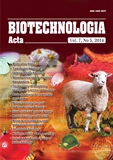ISSN 2410-7751 (Print)
ISSN 2410-776X (Online)

"Biotechnologia Acta" v. 7, no 5, 2014
https://doi.org/10.15407/biotech7.05.085
Р. 85-93, Bibliography10 Ukrainian.
Universal Decimal classification: 637.146, 578.81
THE SEARCH AND PROPERTIES OF LACTIC ACID BACTERIA PERSPECTIVE FOR BIOTECHNOLOGY
Institute of Food Resources of the National Academy of Agrarian Sciences of Ukraine, Kyiv
Search of biologically active Lactobacillus strains prospective for functional milk food production was the aim of the research.
The study involved the lactic acid bacteria isolated from biological material of healthy humen and non- dairy lactic products. Using modern methodological approaches, the strains of lactic acid bacteria such as Lactobacillus casei 302, Lactobacillus acidophilus 35 and Streptococcus thermophilus 21 having high level of biological activity were selected. High biological potential of selected cultures of lactic acid bacteria, which could provide stability for the technological process of production and essential characteristics of bacterial preparations and fermented their products, was set. In vitro the experiments demonstrated that selected strains had valuable production properties, namely the ability to reduce level of cholesterol and lactose during development in milk, were resistant to virulent bacteriophages and aggressive compounds of the gastrointestinal tract, and high adhesive and antagonistic activities as well.
Key words: Lactobacillus саsеі, election, adhesive activities, cholesterol.
© Palladin Institute of Biochemistry of the National Academy of Sciences of Ukraine, 2014
References
1. Lantinen S., Ouwehand A., Salminen S., Wtight A. Lactic acid bacteria microbiological and functional aspects. Fourth edition. CRC Press New RC Press: New York. 2012. P. 2–13.
2. Poltavska O. A., Kovalenko N. K., Uspenskii I. G. Screening of strains of lactic acid bacteria and bifidobacteria for probiotic properties. Mikrobiolohiia і biitekhnolohiia. 2011, N 1, P. 6–16. (In Ukrainian).
3. Gudkov A. V. Cheesemaking: technological, biological and physical and chemical aspects. Moscow: Deli print. 2004. 250 p. (In Russian).
4. Marcy M., Moineau S., Quiberoni A. Bacteriophages and dairy fermentations. Bacteriophage. 2012, 2 (3), 149–155.
http://dx.doi.org/10.4161/bact.21868
5. Lapach S. N., Chubenko A. V., Babich P. N. Statistical methods in biomedical studies using Excel. Kyiv: Morion. 2001. 408 p.(In Russian).
6. Eresko G. O., Kigel N. F., Zhogan G. V. Acid resistance of industrial strains of lactic acid bacteria. Visnyk ahrarnoi nauk. 2003, N 5, P. 66–68. (In Ukrainian).
7. Bos R., van der Mei H., Busser H. Physicochemistry of microbial adhesive interactions — its mechanisms and methods for study. FEMS Microbiol. Rev. 1999, 23(2), 179–230.
http://dx.doi.org/10.1111/j.1574-6976.1999.tb00396.x
8. Marushko U. V., Kigel N. F., Rozhanskaya A. M., Zholobak N. M. Study microbial coenosis tonsils of healthy and sickly children. Mikrobiol. zh. 1999, 61(2), 74–78. (In Ukrainian).
9. Brashears M., Gilliland S., Buck L. Bile salt deconjugation and cholesterol removal from media by L. Casei. J. Dairy Sci. 1998, 81(8), 2103–2110.
http://dx.doi.org/10.3168/jds.S0022-0302(98)75785-6
10. Garneau J., Moineau S. Bacteriophages of lactic acid bacteria and their impact on milk fermentations. Microbial Cell Factories. 2011, 10(2), 1–10.
http://dx.doi.org/10.1186/1475-2859-10-s1-s20

